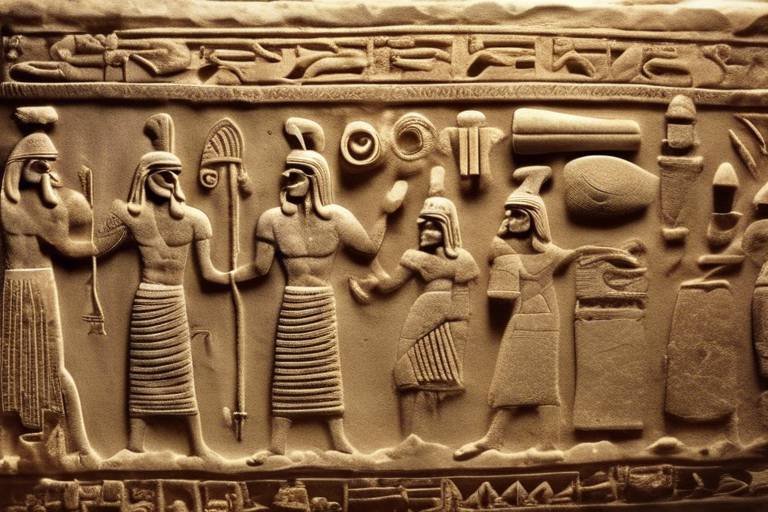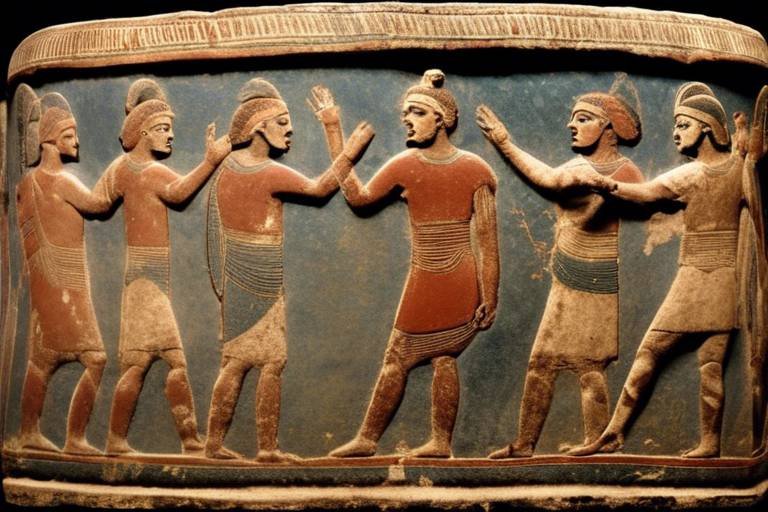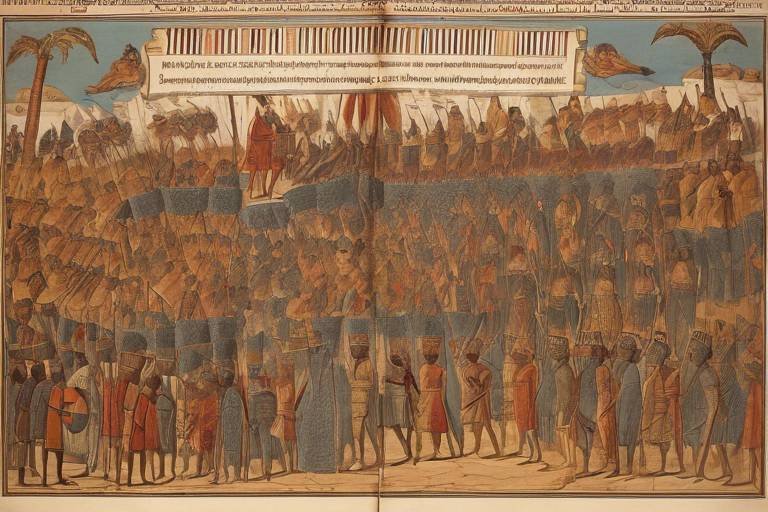The Lost Cities of the Ancestral Puebloans
The Lost Cities of the Ancestral Puebloans hold a mystique that captivates the imagination, drawing us into a world where ancient civilizations thrived amidst the rugged landscapes of the American Southwest. These enigmatic cities, built by the Ancestral Puebloans, stand as testaments to human ingenuity and resilience, echoing the whispers of a bygone era.
As we peel back the layers of time, we uncover the intricate tapestry of history woven by the Ancestral Puebloans. Their journey is a saga of innovation and adaptation, marked by the evolution of societal structures and the ebb and flow of cultural practices that shaped their identity.
Walking through the remnants of their architectural marvels, we are transported to a realm where cliff dwellings cling precariously to canyon walls, and stone masonry stands as a testament to their craftsmanship. The Ancestral Puebloans' mastery of building techniques is a testament to their deep connection with the land and the elements.
Art and culture flourished in the vibrant communities of the Ancestral Puebloans, reflected in the intricate pottery styles, religious beliefs, and ceremonial practices that permeated their daily lives. Each artifact unearthed from the ancient ruins speaks volumes about their creativity and spiritual reverence.
Chaco Canyon emerges as the beating heart of Ancestral Puebloan civilization, a sacred landscape dotted with great houses, kivas, and celestial alignments that speak to a sophisticated understanding of astronomy and architecture. The intricate road networks that crisscross the region bear witness to their advanced urban planning.
Life in the ancient Puebloan cities was a harmonious blend of agriculture, trade, and social cohesion. The bustling urban centers buzzed with activity, as communities thrived through cooperation and shared knowledge, creating a tapestry of interconnected lives.
Yet, as swiftly as they rose, the Puebloan cities faced a mysterious decline, shrouded in theories of environmental challenges and societal shifts. The abrupt abandonment of these once-flourishing settlements leaves us pondering the fragility of civilizations and the resilience of the human spirit.
The legacy of the Ancestral Puebloans endures in the traditions of modern Puebloan tribes, the ongoing archaeological discoveries that shed light on their past, and the profound impact they have had on our understanding of Native American cultures in the Southwest. Their story is a testament to the enduring spirit of a people who thrived in harmony with the land.
Today, efforts to preserve and protect the archaeological sites of the Ancestral Puebloans are paramount, balancing the need for conservation with the opportunities presented by tourism. The delicate dance between safeguarding these ancient wonders and sharing them with the world underscores the importance of honoring the past while embracing the future.

History of the Ancestral Puebloans
The history of the Ancestral Puebloans is a fascinating journey into the past, revealing a complex and advanced civilization that once thrived in the American Southwest. These ancient Native American people, also known as the Anasazi, inhabited the region for thousands of years, leaving behind a legacy of architectural wonders and cultural achievements.
The origins of the Ancestral Puebloans can be traced back to around 1200 BCE when they began to settle in the Four Corners area of the present-day United States. Over time, they developed sophisticated farming techniques, including the cultivation of maize, beans, and squash, which allowed their population to grow and flourish.
As the Ancestral Puebloans expanded their settlements, they built intricate stone structures, such as the iconic cliff dwellings found in places like Mesa Verde and Canyon de Chelly. These architectural marvels not only served as homes but also as centers of social and religious life, showcasing the ingenuity and skill of these ancient builders.
One of the most remarkable aspects of Ancestral Puebloan society was their complex societal structure, which included hierarchical leadership, division of labor, and elaborate ceremonial practices. Their communities were interconnected through trade networks that spanned vast distances, allowing for the exchange of goods and ideas.
However, despite their achievements, the Ancestral Puebloans faced challenges such as droughts, resource depletion, and external pressures from neighboring tribes. By the late 13th century, many of their cities were abandoned, marking the end of this ancient civilization and giving rise to theories about the reasons behind their sudden disappearance.
Today, archaeologists continue to unravel the mysteries of the Ancestral Puebloans, piecing together fragments of pottery, tools, and architectural remains to gain insight into their way of life. Through their study, we can appreciate the resilience and creativity of these early inhabitants of the American Southwest.

Architecture and Engineering Marvels
The of the Ancestral Puebloans stand as a testament to their ingenuity and skill. These ancient people, also known as the Anasazi, created awe-inspiring structures that continue to captivate modern-day observers. One of their most iconic architectural achievements is the cliff dwellings, built into the natural rock formations of the Southwest. These dwellings not only provided shelter but also served as a defense mechanism against potential threats.
Moreover, the Ancestral Puebloans excelled in intricate stone masonry, crafting buildings with precision and artistry. The construction of multi-story buildings using stone blocks without the aid of modern tools is a marvel in itself. The precision with which these structures were built speaks volumes about the engineering knowledge possessed by the ancient Puebloans.
One of the notable sites showcasing their architectural prowess is Mesa Verde, where visitors can witness the cliff dwellings perched precariously on the canyon walls. The strategic location of these dwellings not only provided protection but also offered stunning panoramic views of the surrounding landscape. The Ancestral Puebloans' ability to adapt to their environment and create functional yet beautiful structures is truly remarkable.
Furthermore, the Ancestral Puebloans designed their buildings with a deep understanding of celestial alignments, incorporating astronomical features into their architecture. This integration of astronomy into their structures highlights their advanced knowledge of the natural world and the importance of celestial events in their culture.
In addition to their architectural achievements, the Ancestral Puebloans developed sophisticated irrigation systems to support their agricultural practices in the arid Southwest. The construction of intricate water management systems allowed them to cultivate crops in challenging environments, demonstrating their innovative approach to sustainable living.

Art and Culture of the Ancestral Puebloans
The Art and Culture of the Ancestral Puebloans offer a fascinating glimpse into the creative expressions and spiritual beliefs of this ancient civilization. Through their intricate pottery, elaborate rock art, and ceremonial structures, the Ancestral Puebloans showcased a deep connection to the natural world and a complex social and religious framework.
One of the most distinctive aspects of Ancestral Puebloan art is their pottery. Using sophisticated techniques, they crafted beautiful vessels adorned with intricate geometric designs and symbolic motifs. These pottery styles not only served practical purposes but also held significant cultural and spiritual meanings, reflecting the Puebloans' reverence for nature and their cosmological beliefs.
Furthermore, the rock art left behind by the Ancestral Puebloans provides a window into their visual storytelling and symbolic communication. Intricate petroglyphs and pictographs found in caves and cliffs depict scenes of daily life, hunting rituals, and spiritual ceremonies, offering valuable insights into their cultural practices and beliefs.
The religious beliefs of the Ancestral Puebloans were deeply intertwined with their artistic expressions. Ceremonial structures such as kivas, underground chambers used for rituals and gatherings, were central to their spiritual practices. These sacred spaces were adorned with elaborate murals, symbolic decorations, and architectural features that reflected the Puebloans' cosmology and reverence for the natural elements.
Through their art and culture, the Ancestral Puebloans conveyed a profound respect for the land, the cycles of nature, and the interconnectedness of all living beings. Their artistic legacy continues to inspire admiration and awe, offering a glimpse into the rich tapestry of their civilization that once flourished in the rugged landscapes of the American Southwest.

Chaco Canyon: The Heart of Ancestral Puebloan Civilization
The Ancestral Puebloans, an ancient Native American culture, left behind remarkable cities in the American Southwest. Discover the mystery and grandeur of these lost cities and the civilization that thrived in the region centuries ago.
Chaco Canyon stands as a testament to the ingenuity and spiritual depth of the Ancestral Puebloans. Nestled in the rugged landscape of present-day New Mexico, this archaeological wonder served as the beating heart of their civilization. The canyon, with its towering cliffs and expansive vistas, was not merely a collection of buildings but a living, breathing center of culture and ceremony.
Q: What caused the decline of the Ancestral Puebloan civilization?
A: The decline of the Ancestral Puebloan civilization is attributed to a combination of factors, including environmental changes, resource depletion, social unrest, and possibly external pressures from neighboring groups.
Q: How are modern Puebloan tribes connected to the Ancestral Puebloans?
A: Modern Puebloan tribes trace their heritage back to the Ancestral Puebloans and maintain cultural and spiritual ties to their ancestors through shared traditions, language, and oral histories.
Q: What efforts are being made to preserve Ancestral Puebloan sites?
A: Various organizations, including tribal authorities, government agencies, and archaeological groups, are actively involved in preserving and protecting Ancestral Puebloan sites through conservation measures, educational programs, and sustainable tourism practices.

Life in the Ancient Puebloan Cities
Life in the Ancient Puebloan Cities was a fascinating blend of communal living, intricate social structures, and sustainable agricultural practices. The Puebloans built their cities in strategic locations, often near water sources and arable land, to support their agricultural endeavors. These cities were bustling hubs of activity, with multi-story buildings made of stone and adobe, interconnected by narrow passageways and staircases.
The daily life of the Ancient Puebloans revolved around agriculture, primarily corn, beans, and squash, which formed the staple of their diet. They utilized advanced irrigation techniques to cultivate crops in the arid desert environment, showcasing their ingenuity and resourcefulness. Trade also played a significant role in their society, with goods such as turquoise, pottery, and textiles exchanged among different Puebloan communities.
Family and community were central to Puebloan life, with extended families living together in large communal dwellings known as kivas. These underground structures served as gathering places for ceremonies, rituals, and social gatherings, reflecting the close-knit nature of Puebloan society. The Puebloans also had a complex social hierarchy, with leaders overseeing religious ceremonies and community decisions.
Religious beliefs were deeply intertwined with daily life in the Ancient Puebloan cities, as evidenced by the presence of kivas, petroglyphs, and elaborate pottery designs. The Puebloans practiced ceremonial rituals to honor their deities, seek protection, and ensure bountiful harvests. Their art and architecture were imbued with spiritual significance, reflecting their connection to the natural world and the cosmos.
Despite the challenges of living in a harsh desert environment, the Ancient Puebloans thrived for centuries, adapting to their surroundings and creating a vibrant cultural legacy that endures to this day. Their resilience, creativity, and communal spirit continue to inspire admiration and curiosity among archaeologists, historians, and visitors to the Southwest.

Reasons for the Abandonment of Puebloan Cities
As the sun set on the once-thriving Puebloan cities, a veil of mystery descended over their sudden abandonment. Researchers have long pondered the enigmatic reasons behind the exodus of the Ancestral Puebloans from their urban centers around the 13th century. Various theories have emerged, each offering a glimpse into the possible factors that contributed to the downfall of these ancient civilizations.
One prevalent hypothesis suggests that environmental changes played a significant role in the desertion of the Puebloan cities. Droughts, crop failures, and resource depletion may have exerted immense pressure on the communities, leading to food shortages and internal strife. The harsh desert landscape, once a source of sustenance, could have transformed into a formidable adversary, driving the inhabitants to seek greener pastures elsewhere.
Another compelling explanation revolves around social upheaval within the Puebloan society. Conflict, competition for resources, and political instability might have destabilized the intricate social fabric that held the communities together. As tensions escalated and alliances fractured, the once-unified Puebloan cities may have crumbled under the weight of internal discord.
Furthermore, the arrival of external forces, such as nomadic tribes or neighboring civilizations, could have catalyzed the abandonment of the Puebloan cities. In the face of new threats and unfamiliar power dynamics, the inhabitants may have chosen to vacate their ancestral homes in a bid for survival. The prospect of conflict and subjugation may have prompted a mass exodus, scattering the Puebloan populations across the vast Southwest.
While the precise reasons for the abandonment of the Puebloan cities remain shrouded in ambiguity, the echoes of their enigmatic disappearance continue to resonate through the corridors of time. The legacy of the Ancestral Puebloans endures as a testament to the resilience and ingenuity of a civilization that once thrived amidst the arid landscapes of the American Southwest.

Legacy of the Ancestral Puebloans
The legacy of the Ancestral Puebloans continues to resonate in the modern world, leaving a profound impact on various aspects of society. Their architectural prowess and cultural achievements have captivated historians, archaeologists, and the general public alike, shedding light on the ingenuity and resilience of this ancient civilization.
One of the most enduring legacies of the Ancestral Puebloans is their influence on contemporary Puebloan tribes. The traditions, craftsmanship, and spiritual practices passed down through generations serve as a testament to the enduring connection between past and present. The intricate pottery styles and artistic motifs of the Ancestral Puebloans have inspired modern artisans, keeping their cultural heritage alive.
Archaeology owes a great deal to the Ancestral Puebloans, as their well-preserved sites offer invaluable insights into pre-Columbian history. The meticulous excavation and study of Puebloan ruins have advanced our understanding of ancient Native American cultures, providing a window into a bygone era that would otherwise remain shrouded in mystery.
Furthermore, the legacy of the Ancestral Puebloans extends beyond academia, influencing popular culture and fostering a sense of wonder and curiosity about the past. Their cliff dwellings and kivas have become iconic symbols of the American Southwest, attracting tourists from around the world who seek to immerse themselves in the ancient world of the Puebloans.
In conclusion, the legacy of the Ancestral Puebloans serves as a reminder of the enduring impact of indigenous cultures and the importance of preserving our shared heritage. By honoring and celebrating the achievements of these ancient peoples, we not only pay tribute to their legacy but also enrich our collective understanding of human history.

Preservation Efforts and Tourism
Preservation efforts play a crucial role in safeguarding the invaluable archaeological sites of the Ancestral Puebloans for future generations. Through meticulous conservation work and ongoing research, experts strive to protect these ancient remnants from natural erosion and human interference. Preservation initiatives often involve a combination of structural reinforcement, site monitoring, and educational programs to raise awareness about the significance of these historical treasures.
On the other hand, tourism presents both opportunities and challenges in the context of preserving Ancestral Puebloan sites. While increased visitor numbers can generate revenue for conservation efforts and promote cultural appreciation, uncontrolled tourism may pose threats to the fragile remains through foot traffic, vandalism, and looting. Balancing the need for public access with the imperative of site protection remains a delicate task that requires careful planning and management.
Efforts to promote sustainable tourism practices, such as guided tours, visitor centers, and designated viewing areas, aim to minimize the negative impact on archaeological sites while enhancing the overall visitor experience. By fostering a sense of stewardship among tourists and local communities, these initiatives contribute to the long-term sustainability of Ancestral Puebloan heritage sites.
Frequently Asked Questions
- What is the significance of the Ancestral Puebloan civilization?
The Ancestral Puebloans were known for their advanced architectural techniques, intricate stone masonry, and rich cultural traditions. Their civilization left a lasting impact on the American Southwest and continues to fascinate archaeologists and historians today.
- How did the Ancestral Puebloans build their cliff dwellings?
The Ancestral Puebloans constructed their cliff dwellings using a combination of stone, adobe, and wooden beams. These structures were built into natural alcoves in cliffs, providing protection from the elements and potential enemies.
- What caused the abandonment of the Puebloan cities?
There are various theories surrounding the sudden abandonment of the Ancestral Puebloan cities, including environmental factors such as drought, social unrest, and conflict. The exact reasons remain a topic of debate among researchers.
- How are the archaeological sites of the Ancestral Puebloans preserved?
Preservation efforts for Ancestral Puebloan sites involve a combination of physical conservation, site monitoring, public education, and collaboration with Native American tribes. These initiatives aim to protect the cultural heritage of the Puebloans for future generations.
- What is the legacy of the Ancestral Puebloans on modern Puebloan tribes?
The legacy of the Ancestral Puebloans can be seen in the cultural practices, artistic traditions, and spiritual beliefs of modern Puebloan tribes. These connections to the past help preserve the heritage and identity of contemporary indigenous communities.



















